No CrossRef data available.
Article contents
Explicating the Conceptual Basis of Language*
Published online by Cambridge University Press: 26 September 2008
Abstract
An abstract is not available for this content so a preview has been provided. Please use the Get access link above for information on how to access this content.

- Type
- Notes and discussion
- Information
- Copyright
- Copyright © Cambridge University Press 1982
Footnotes
[*]
Preparation of this Note was supported by grants to the University of Chicago from the Spencer Foundation and the Sloan Foundation. I am indebted, as always, to Nobuko B. McNeill for commenting on the paper. Address for correspondence: Center for Cognitive Science, University of Chicago, Beecher Hall, 5848 South University Ave., Chicago, 111. 60637, U.S.A.
References
REFERENCES
Bates, E. (1980). Review of the conceptual basis of language. American Scientist 68. 702.Google Scholar
Bernstein, N. A. (1967). The co-ordination and regulation of movements. Oxford: Pergamon Press.Google Scholar
Bresnan, J. (1978). A realistic transformational grammar. In Halle, M., Bresnan, J. and Miller, G. A. (eds.), Linguistic theory and psychological reality. Cambridge, Mass.: M.I.T. Press.Google Scholar
Greenfield, P. M. (1978). Structural parallels between language and action in development. In Lock, A. J. (ed.), Action, gesture and symbol: the emergence of language. New York: Academic Press.Google Scholar
Kozhevnikov, V. A. & Chistovich, L. A. (1965). Speech: articulation and perception. Washington: U.S. Department of Commerce, Joint Publication Research Service (30,543).Google Scholar
Lakoff, G. & Johnson, M. (1980). Metaphors we live by. Chicago: University of Chicago Press.Google Scholar
McNeill, D. (1975). Semiotic extension. In Solso, R. L. (ed.), Information processing and cognition. Hillsdale: Erlbaum.Google Scholar
Peirce, C. S. (1931–1958). The collected works of Charles Sanders Peirce (Harshorne, C. & Weiss, P., eds.). Cambridge, Mass.: Harvard University Press.Google Scholar
Piaget, J. (1952). The origins of intelligence in children. New York: International Humanities Press.CrossRefGoogle Scholar
de Saussure, F. (1959). Course in general linguistics. New York: Philosophical Library. (First published in 1915.)Google Scholar
Werner, H. (1948). Comparative psychology of mental development. Chicago: Follett Publishing Company.Google Scholar
Wittgenstein, L. (1961). Tractatus logico-philosophicus. (Trans, by Pears, D. F. and Mc-Guinness, B. F..) London: Routledge & Kegan Paul.Google Scholar


